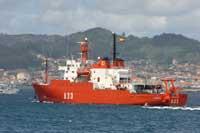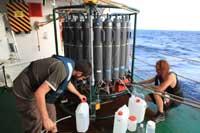Malaspina 2010, in the current of climate change

Malaspina 2010 is the name of the circumcision expedition that is being carried out with the aim of conducting a deep oceanographic study in all the oceans of the world. Multidisciplinary researchers have set sail for seven months to perform various measurements and analyses. The final objective of the expedition is to take a "picture" of the ocean situation and see how climate change is affecting.
The Malaspina 2010 expedition owes its name to the scientist Alejandro Malaspina. He led the first Spanish circumcision expedition for scientific purposes in the 18th century. It began in 1789 and for five years studied carefully the seas and lands of America, Asia and Oceania on the Daring and Uncovered ships.
On the 200th anniversary of his death, hundreds of people travel aboard the Hesperides boat. In fact, the boat itself and its crew are military, but it is dedicated to scientists. It has numerous laboratories and measuring tools.

The expedition is sailing the world in six stages involving a total of 250 researchers, including three researchers from the University of the Basque Country studying marine microbes, and a researcher from AZTI-Tecnalia investigating zooplankton. As explained by Juan Iriberri, head of the marine microbes team of the UPV-EHU, "not all researchers can be at once on the boat because there is no place". Therefore, the researchers of the UPV/EHU have been in four of the six stages, in the first two they have been a researcher and in the last two a researcher. The last stage between Colombia and Cadiz is currently being developed. In July the expedition of the boat ends and it is then that the time begins to analyze the collection of samples collected. Researchers envision a work of many years.
Sampling and commissioning
In addition to the continuous measurement of various aquatic parameters worldwide, such as the exchange of gases between water and the atmosphere, during the Malaspina 2010 expedition water samples will be taken. They will be collected in 180 predefined stations and it is very important for researchers to be able to take samples of water at great depths. According to Iriberri, "we only know the surface of the ocean, about 200 first lit meters. As for what is below, we know little."
A device called a rosette is launched into the sea. The device is able to take samples at ten depths in a given water column and down to 6,000 meters deep. The rosette has several bottles that form a circle and each of them closes at a certain depth. UPV researcher Zuriñe Baña explained the sampling process: "At four in the morning, the boat stops to catch water, after moving from one place to another during the night. First, we look at the characteristics of the sea column and, depending on it, we decide at what depth we will take samples of water." Some of the collected samples are examined immediately in the container laboratory. Another part is preserved at -80ºC for further study.

Water samples, once on the boat, are examined by researchers from all disciplines, in order to check whether they are of interest in their field of research. Due to the presence of researchers from different fields of research, many measurements are made. Some observe the physical characteristics of water, such as temperature, salinity, and oxygen concentration. Others look for living beings (these researchers are divided into three groups: some look for microbes, i.e. viruses, bacteria, etc. ; others look for small algae and other small animals). Other groups measure pollutants emitted by humans to determine the degree of water pollution in water samples, etc.
In this way, they will get a lot of information about the current situation of all the world's oceans. In addition, with samples stored at -80ºC is forming the "Malaspina Collection". This collection "will remain intact for 30 years. In this way, researchers who have not yet been born will be able to analyze these samples with a much greater technological capacity. It is very valuable," said Professor Iriberri.
Published in Ortzadar
Buletina
Bidali zure helbide elektronikoa eta jaso asteroko buletina zure sarrera-ontzian











